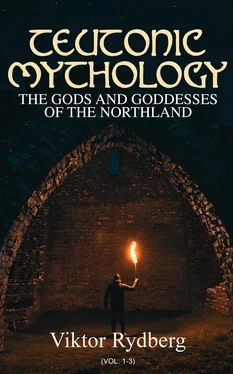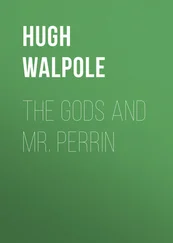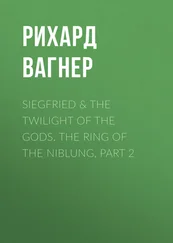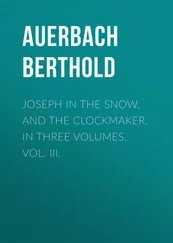Thus we have found that the three characteristic points—
unsuccessful cremation of an evil giantess,
her regeneration after the cremation,
the same woman as mother of the Fenrer race—
are common to Gulveig-Heid and Angerboda.
Their identity is apparent from various other circumstances, but may be regarded as completely demonstrated by the proofs given. Gulveig's activity in antiquity as the founder of the diabolical magic art, as one who awakens man's evil passions and produces strife in Asgard itself, has its complement in Angerboda's activity as the mother and nourisher of that class of beings in whose members witchcraft, thirst for blood, and hatred of the gods are personified. The activity of the evil principle has, in the great epic of the myth, formed a continuity spanning all ages, and this continuous thread of evil is twisted from the treacherous deeds of Gulveig and Loke, the feminine and the masculine representatives of the evil principle. Both appear at the dawn of mankind: Loke has already at the beginning of time secured access to Alfather (Lokasenna, 9), and Gulveig deceives the sons of men already in the time of Heimdal's son Borgar. Loke entices Idun from the secure grounds of Asgard, and treacherously delivers her to the powers of frost; Gulveig, as we shall see, plays Freyja into the hands of the giants. Loke plans enmity between the gods and the forces of nature, which hitherto had been friendly, and which have their personal representatives in Ivalde's sons; Gulveig causes the war between the Asas and Vans. The interference of both is interrupted at the close of the mythic age, when Loke is chained, and Gulveig, in the guise of Angerboda, is an exile in the Ironwood. Before this they have for a time been blended, so to speak, into a single being, in which the feminine assuming masculineness, and the masculine effeminated, bear to the world an offspring of foes to the gods and to creation. Both finally act their parts in the destruction of the world. Before that crisis comes Angerboda has fostered that host of "sons of world-ruin" which Loke is to lead to battle, and a magic sword which she has kept in the Ironwood is given to Surt, in whose hand it is to be the death of Frey, the lord of harvests (see Nos. 89, 98, 101, 103).
That the woman who in antiquity, in various guises, visited Asgard and Midgard was believed to have had her home in the Ironwood [18]of the East during the historical age down to Ragnarok is explained by what Saxo says—viz., that Odin, after his return and reconciliation with the Vans, banished the agents of the black art both from heaven and from earth. Here, too, the connection between Gulveig-Heid and Angerboda is manifest. The war between the Asas and Vans was caused by the burning of Gulveig by the former. After the reconciliation with the Asas this punishment cannot again be inflicted on the regenerated witch. The Asas must allow her to live to the end of time; but both the clans of gods agree that she must not show her face again in Asgard or Midgard. The myth concerning the banishment of the famous vala to the Ironwood, and of the Loke progeny which she there fosters, has been turned into history by Jordanes in his De Goth. Origine , ch. 24, where it is stated that a Gothic king compelled the suspected valas ( haliorunas ) found among his people to take their refuge to the deserts in the East beyond the Mœotian Marsh, where they mixed with the wood-sprites, and thus became the progenitors of the Huns. In this manner the Christian Goths got from their mythic traditions an explanation of the source of the eastern hosts of horsemen, whose ugly faces and
barbarous manners seemed to them to prove an other than purely human origin. The vala Gulveig-Heid and her like become in Jordanes these haliorunæ ; Loke and the giants of the Ironwood become these wood-sprites; the Asa-god who caused the banishment becomes a king, son of Gandaricus Magnus (the great ruler of the Gandians, Odin), and Loke's and Angerboda's wonderful progeny become the Huns.
Stress should be laid on the fact that Jordanes and Saxo have in the same manner preserved the tradition that Odin and the Asas, after making peace and becoming reconciled with the Vans, do not apply the death-penalty and burning to Gulveid-Heid-Angerboda and her kith and kin, but, instead, sentence them to banishment from the domains of gods and men. That the tradition preserved in Saxo and Jordanes corresponded with the myth is proved by the fact that we there rediscover Gulveig-Heid-Angerboda with her offspring in the Ironwood, which was thought to be situated in the utmost East, far away from the human world, and that she remains there undisturbed until the destruction of the world. The reconciliation between the Asas and Vans has, as this conclusively shows, been based on an admission on the part of the Asas that the Vans had a right to find fault with and demand satisfaction for the murder of Gulveig-Heid. Thus the dispute which caused the war between Asas and Vans was at last decided to the advantage of the latter, while they on their part, after being satisfied, reinstate Odin in his dignity as universal ruler and father of the gods.
(b) Gulveig-Heid-Angerboda identical with Aurboda.
In the Ironwood dwells Angerboda, together with a giant, who is gygjar hirdir , the guardian and watcher of the giantess. He has charge of her remarkable herds, and also guards a sword brought to the Ironwood. This vocation has given him the epithet Egther ( Egtherr —Völuspa), which means sword-guardian. Saxo speaks of him as Egtherus, an ally of Finns, skilled in magic, and a chief of Bjarmians, equally skilful in magic (cp. Hist. , 248, 249, with Nos. 52, 53). Bjarmians and Finns are in Saxo made the heirs of the wicked inhabitants of Jotunheim. Vilkinasaga knows him by the name Etgeir, who watches over precious implements in Isung's wood. Etgeir is a corruption of Egther, and Isung's wood is a reminiscence of Isarnvidr , Isarnho , the Ironwood. In the Vilkinasaga he is the brother of Vidolf. According to Hyndluljod, all the valas of the myth come from Vidolf. As Gulveig-Heid-Angerboda is the chief of all valas, and the teacher of the arts practised by the valas this statement in Hyndluljod makes us think of her particularly; and as Hrimnir's daughter has been born and burnt several times, she may also have had several fathers. Among them, then, is Vidolf, whose character, as described by Saxo, fits well for such a daughter. He is a master in sorcery, and also skilful in the art of medicine. But the medical art he practises in such a manner that those who seek his help receive from him such remedies as do harm instead of good. Only by threats can he be made to do good with his art ( Hist. , 323, 324). The statement in Vilkinasaga compared with that in Hyndluljod seems therefore to point to a near kinship between Angerboda and her sword-guard. She appears to be the daughter of his brother.
In Völuspa's description of the approach of Ragnarok, Egther Angerboda's shepherd, is represented as sitting on a mound—like Aurboda's shepherd in Skirnisför —and playing a harp, happy over that which is to happen. That the giant who is hostile to the gods, and who is the guardian of the strange herds, does not play an idyl on the strings of his harp does not need to be stated. He is visited by a being in the guise of the red cock. The cock, says Völuspa, is Fjalarr (str. 44).
What the heathen records tell us about Fjalar is the following: [19]
(a) He is the same giant as the Younger Edda (i. 144 ff.) calls Utgard-Loke. The latter is a fire-giant, Loge's , the fire's ruler (Younger Edda, 152), the cause of earthquakes (Younger Edda, 144), and skilled in producing optical delusions. Fjalar's identity with Utgard-Loke is proved by Harbardsljod, str. 26, where Thor, on his way to Fjalar, meets with the same adventures as, according to the Younger Edda, he met with on his way to Utgard-Loke.
Читать дальше











